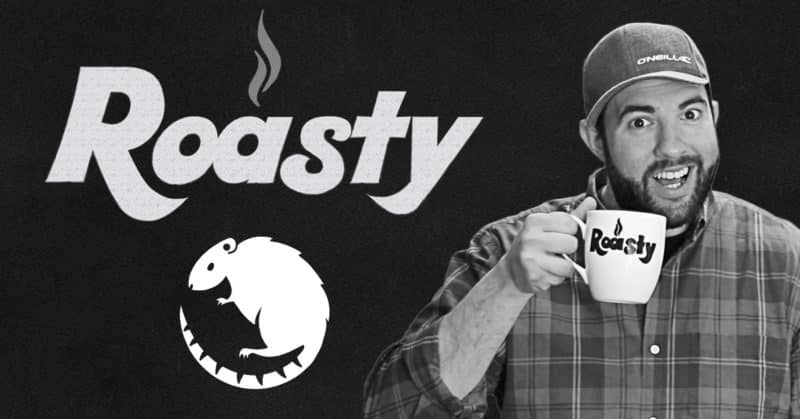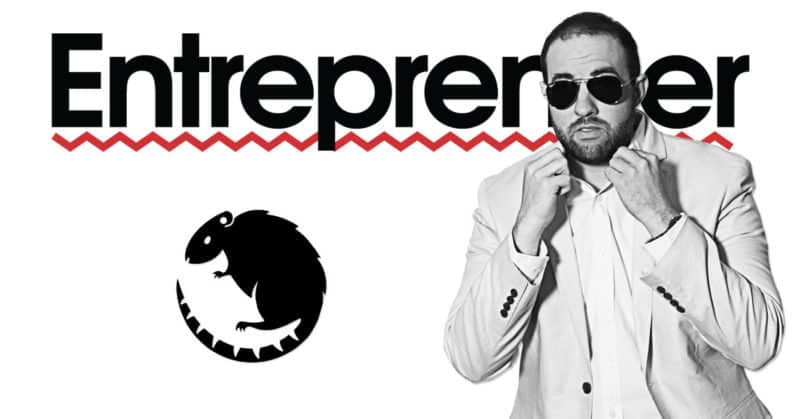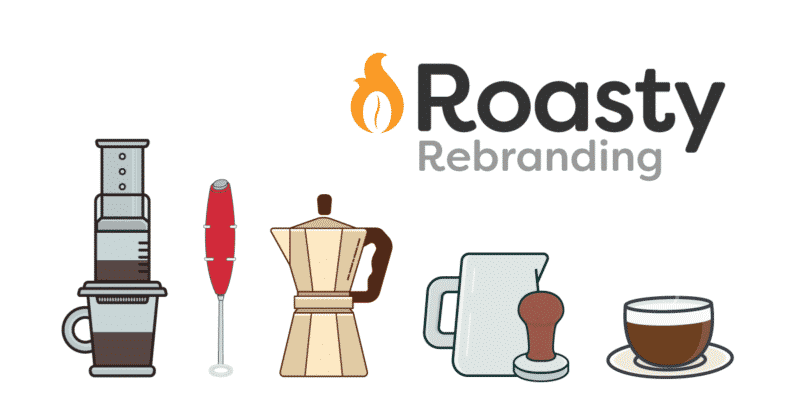The Hypothesis
Can I build a brand new site similar to SwimU and Roasty, but about homebrewing beer? Yes, that’s easy. I’ve done it before. Will this new homebrewing site make money, even if I ignore the competition and keyword research? Sure. But I don’t know how much and when (again, I’ve done it before). So let’s find out 🙂What I’m Starting With
Designing and building websites is a strength of mine. And I really enjoy it. I’ll personally design and code every inch of this new site. However, I may turn to help when creating articles and videos. I have experience and resources I’ve built up over the years (like code blocks, plugins, and design elements). I also pay for hosting at WP Engine for my other sites. So hosting’s taken care of.How Did I Choose To Build a “Niche Site” About Homebrewing?
I know there’s a lot of “content” out there about building “niche sites.” The conventional method:- Do keyword research to find trending and under-served keywords.
- Build a simple WordPress site about one of those keywords.
- Hire some SEO writers on Upwork or another shitty content mill.
- Add some affiliate links.
- Watch the traffic from Google roll in while you laugh all the way to the bank with affiliate checks!
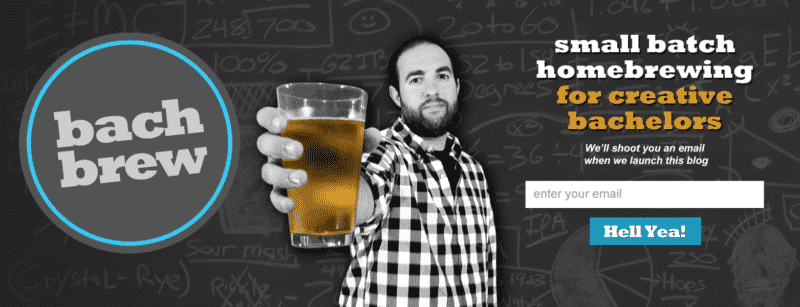
What’s The Goal?
The goal is to make money (hi and welcome to Money Lab). I’d also like to start brewing more, and this gives me another reason. As a by-product, I’ll meet new friends in the industry, and earn some free brewing gear – you should see how much free coffee gear I have. I’ll continue to update this post, including traffic, subscribers, and revenue. My plan is to create in-depth articles that rank on Google and drive traffic to the site. This will increase the subscribers and revenue over time. It’ll work just like SwimU (earned $180,000 in 2016 and is 10 years old) and Roasty (earned $26,000 in 2016 and is two years old). More on this soon.How Will This Site Make Money?
To start, I’ll be using an Amazon Affiliate Plugin that I coded myself. It’s been my secret weapon on my other sites. This is an easy start to make a little money from the site. I’ll also be open to sponsorship deals, but I won’t actively pursue them. That means, if a good company finds out about the site and wants to advertise, I’ll take their money. And, in the near future, I’ll develop a series of digital products around homebrewing. The easiest would be video courses and downloadable guides. But I also have an idea for software that allows homebrewers to keep track of their brews.How Long Will It Take to Make Money?
As with Roasty, the first year could be slow. I might not make any money. In fact, I might lose money (in time and actual cash). Roasty took two years to become profitable, so my plan is to make this site profitable in only ONE year. I’m learning from the mistakes I’ve made in the past with both sites. On SwimU, I didn’t add affiliate links until much later. Instead, I just focused on traffic and Adsense, which did not pay off. On Roasty, I only added affiliate links and tried getting sponsors before I had decent traffic. That really blew up in my face. I should’ve focused on building my email list and my own products (which will finally happen in February 2017 with the first Roasty video course). Again, this is not just a “niche site” for me. It’s a full-on brand that I plan to run and grow for the rest of my life. In other words, it’s an investment.The Plan
1. Choose a Domain and Brand Name
One morning after breakfast, Steph and I sat in the living room brainstorming names for the site. The only caveat was the name had to have the word “brew” in it. I insisted. When I come up with brand names, I try to think about the future. This is why I chose the name “Swim University” instead of “Pool University.” “Pool University” is limiting and pegs it as just a pool website. However, using the word “Swim,” I can talk about any body of water, even the sport of swimming. This allows me to expand topics in the future, like hot tubs and/or swim spas. The word “brew” allows me to expand into all types of things that are brewed, including cider, wine, and coffee (holy synergy, Batman!). We riffed on a bunch of names, but the one that I liked the most was “Brew Cabin.” I’m obsessed with cabins. I moved to Colorado because I enjoy the mountains, the snow, and the dream of living in a remote cabin. Plus, maybe one day I could actually build my own brew cabin 🙂 I tried buying BrewCabin.com on GoDaddy, but it was taken. So I went with BrewCabin.co. (I only pick .com and .co names because I like the way they sound. Not for SEO purposes.)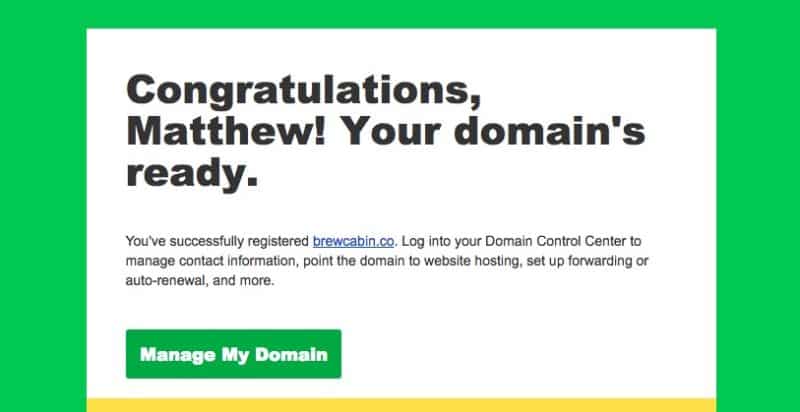 However, I spent some money on GoDaddy’s Domain Buy Service. This is something I’ve never done before.
BrewCabin.com doesn’t have an active website. So for $70, GoDaddy will broker a deal with the owner of the domain on your behalf. I’m not sure what happens if they don’t accept the offers I’ve submitted. I guess I’ll lose that $70. But I REALLY want that .com.
However, I spent some money on GoDaddy’s Domain Buy Service. This is something I’ve never done before.
BrewCabin.com doesn’t have an active website. So for $70, GoDaddy will broker a deal with the owner of the domain on your behalf. I’m not sure what happens if they don’t accept the offers I’ve submitted. I guess I’ll lose that $70. But I REALLY want that .com.
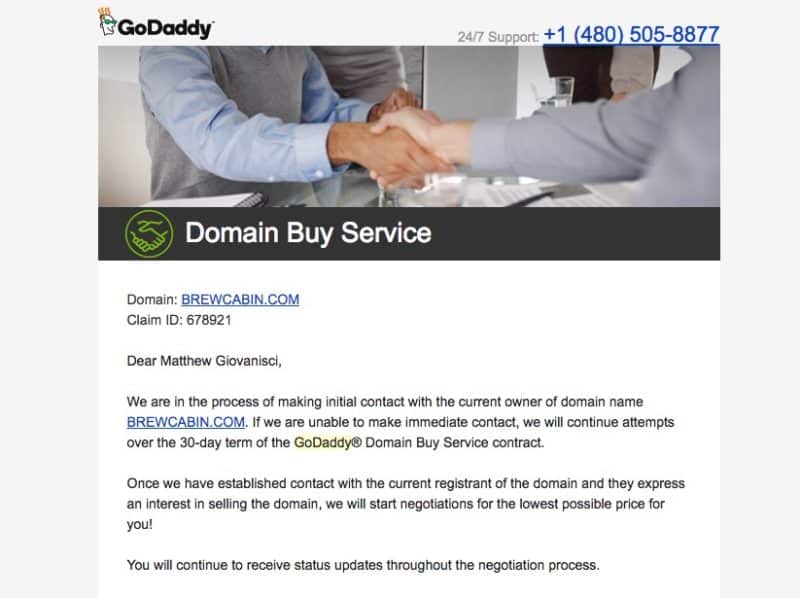 If I don’t get it, I’ll be happy with the .co. I’m going to start building on the .co, and I’ll make the switch if I get it. I should find out in early February 2017.
If I don’t get it, I’ll be happy with the .co. I’m going to start building on the .co, and I’ll make the switch if I get it. I should find out in early February 2017.
2. Create The Brand Logo
Whenever I build a website, I ALWAYS start with the logo. I spend a lot of time on it too. The logo will dictate how the rest of the site will be designed. The first thing I did was look for inspiration. I searched Dribbble and Google images with the terms “beer logo” and “cabin logo” just to see if I liked any of the styles out there. I stored all the images I liked on a secret Pinterest board: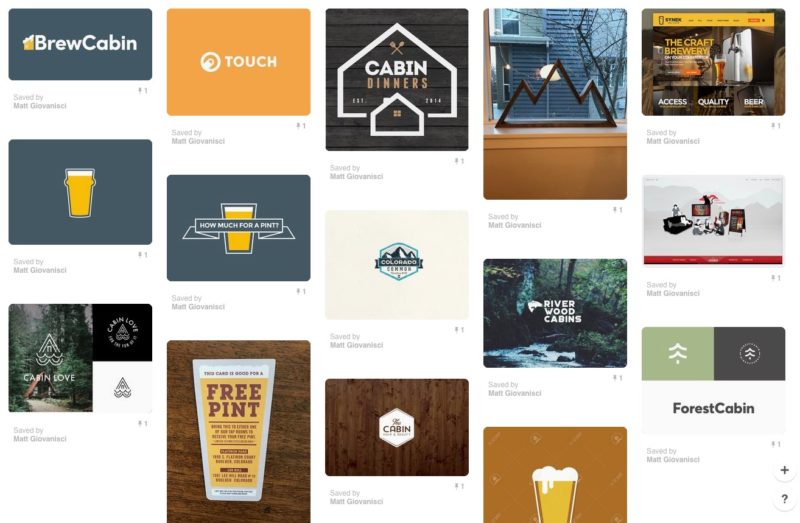 You may notice the first image is the finished logo 😉
I started with picking the logo font. I used Adobe TypeKit (which comes with my subscription of the Adobe Creative Cloud for $50/month).
I wanted something similar to the “ForestCabin” image in the Pinterest board above. I found something pretty close with a font called Sofia Pro. I made a slight modification to the dot above the “i” in “Cabin” (I rounded the corners). Here’s what I ended up with:
You may notice the first image is the finished logo 😉
I started with picking the logo font. I used Adobe TypeKit (which comes with my subscription of the Adobe Creative Cloud for $50/month).
I wanted something similar to the “ForestCabin” image in the Pinterest board above. I found something pretty close with a font called Sofia Pro. I made a slight modification to the dot above the “i” in “Cabin” (I rounded the corners). Here’s what I ended up with:
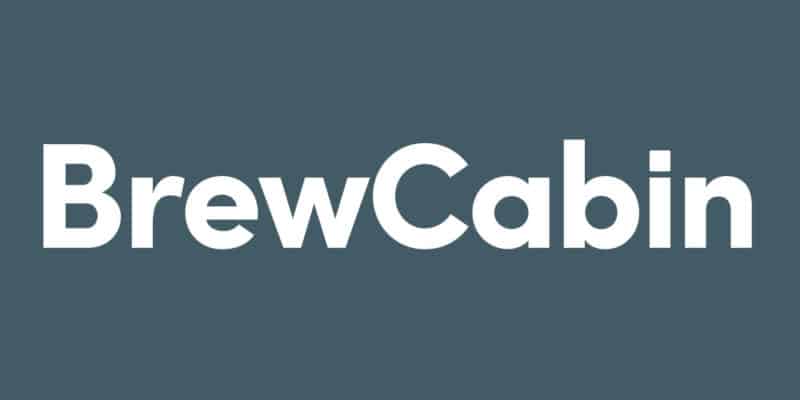 I took some elements I liked, colors, and tried to come up with a clever way to incorporate beer and a cabin image. I played around with a few different designs and colors until I ended up with this:
I took some elements I liked, colors, and tried to come up with a clever way to incorporate beer and a cabin image. I played around with a few different designs and colors until I ended up with this:
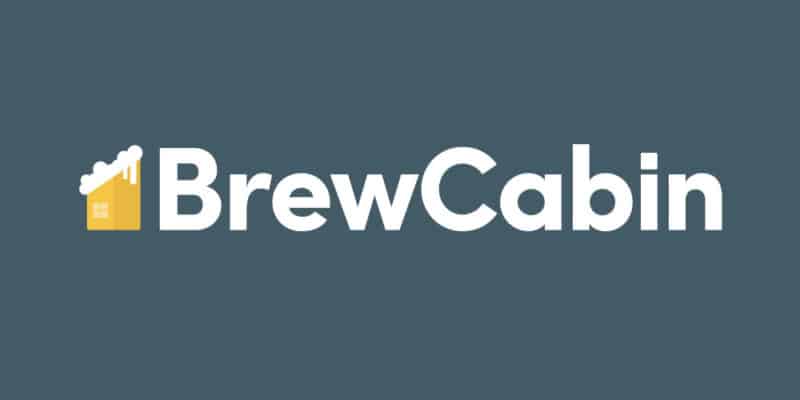
3. Design The Layout of a Single Post Page with Navigation
I always start with article design. Most people who find the site online won’t land on the homepage; they’ll land on a specific article. So that’s where I need to put my best foot forward. Because we’re just starting, I’m not going to over-design this page. I plan to keep it simple and readable. Much like the layout of my other sites, including Money Lab. What will that likely include?- Clean and slim top navigation bar.
- Big and bold headline in the new Sofia Pro font using Typekit.
- 18px sans-serif font slightly lighter than black. Maybe #333333 or #666666. That’s usually my go-to colors for black fonts on white backgrounds.
- No sidebar.
- Email signup box under the article.
4. Design The Homepage and The Rest of The Site
I’m taking the same approach I did with Roasty: the homepage will be the ONLY page on the site that holds all the content. Since we’re not starting with a lot of articles, it would be stupid for me to create category pages. Instead, all the articles will live on the homepage. That’s why I started Roasty until I had about 50 articles. Then, I was able to categorize them and build sub-pages to make it easier to navigate. Over time the homepage will evolve, but for now, I will include an email signup and all the articles in a grid. Like this: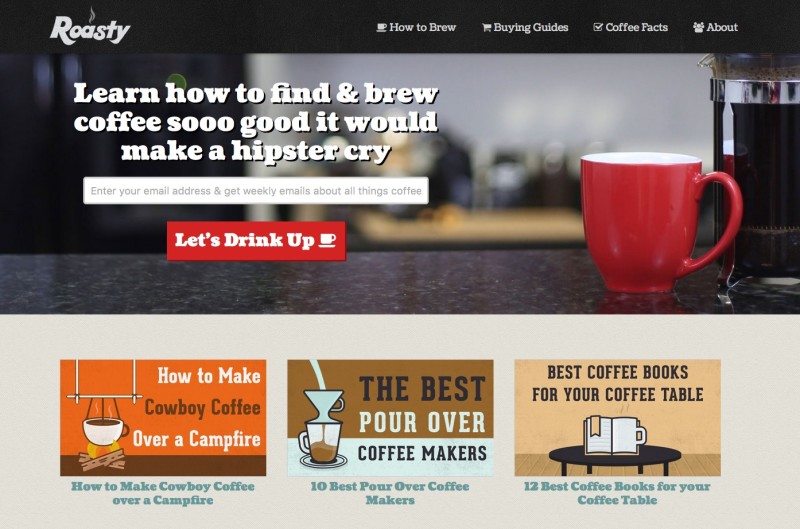
5. Create a Massive List of Article Topics
I’ll sit down at my desk and think about all the things I’d like to know about homebrewing and write them in an Asana project. Just brain dump a bunch of article ideas first. I may even open up a few of my homebrewing books and find some topics. Here’s what the Asana project for Swim University currently looks like. These topics either came from my head or questions from readers via email and Facebook: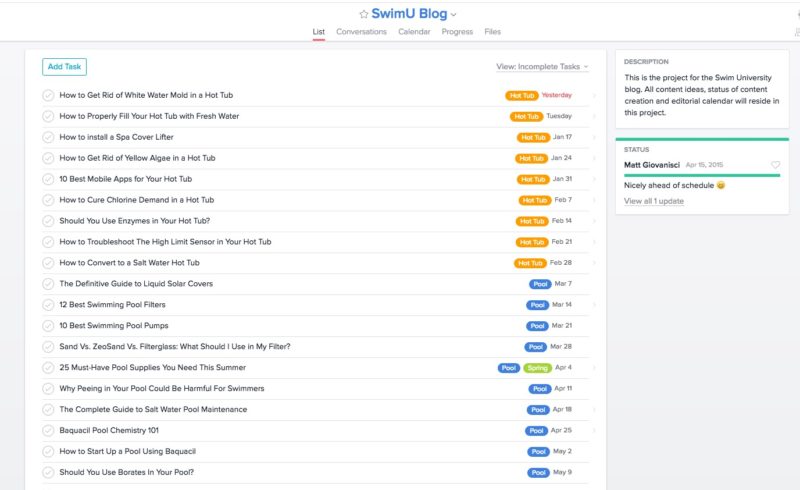 The colorful tags on the right are categories. On Swim University there are only two: pool and hot tub. Each article has a due date, which is the publish date. Looks like we’re late on one. Whoops!
Homebrewing will supply an endless amount of topics, I already know that. And I can start with the basic how-to stuff and move onto more complex topics like attenuation and isomerization.
Once I have all the topics, I need to craft headlines. This is where I’ll do some research.
I’ll use two tools to craft headlines: SEM Rush and Headline Analyzer. SEM Rush helps me to choose the right keyword to use in the headline. My goal is to use the more popular term.
For example, my original idea may be “how to clean your homebrew pot.” I know there are other terms like, “homebrew kettle” or “brew kettle.”
I’ll pop these into SEM Rush (I use the free version, but you’re limited) to see which term gets more searches.
The colorful tags on the right are categories. On Swim University there are only two: pool and hot tub. Each article has a due date, which is the publish date. Looks like we’re late on one. Whoops!
Homebrewing will supply an endless amount of topics, I already know that. And I can start with the basic how-to stuff and move onto more complex topics like attenuation and isomerization.
Once I have all the topics, I need to craft headlines. This is where I’ll do some research.
I’ll use two tools to craft headlines: SEM Rush and Headline Analyzer. SEM Rush helps me to choose the right keyword to use in the headline. My goal is to use the more popular term.
For example, my original idea may be “how to clean your homebrew pot.” I know there are other terms like, “homebrew kettle” or “brew kettle.”
I’ll pop these into SEM Rush (I use the free version, but you’re limited) to see which term gets more searches.
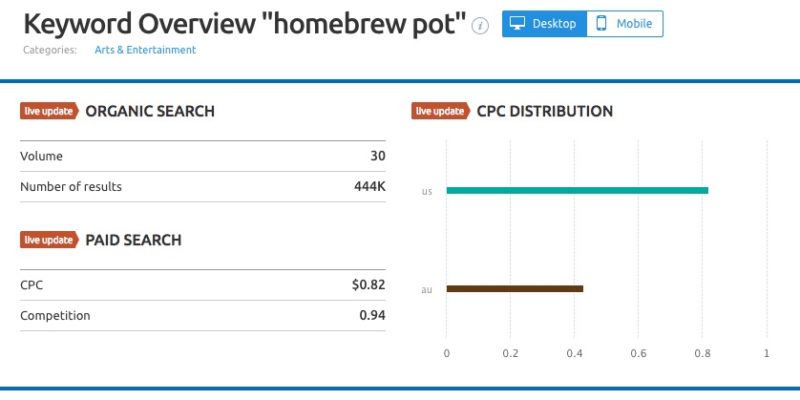 Ok, that’s 30 searches a month. Versus…
Ok, that’s 30 searches a month. Versus…
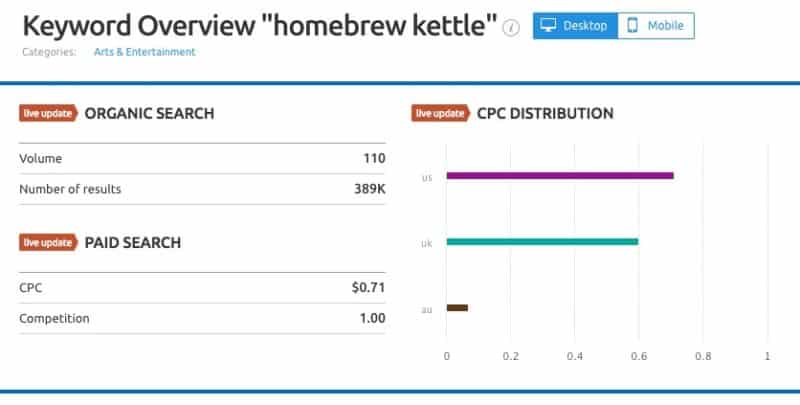 Looks like “homebrew kettle” is a more popular phrase at 110 searches! Now I’ll use Headline Analyzer (free) to help me craft a headline.
NOTE: I really don’t have to use this tool because “How To Clean Your Homebrew Kettle” is pretty straightforward. But maybe we can beef it up a bit…
Looks like “homebrew kettle” is a more popular phrase at 110 searches! Now I’ll use Headline Analyzer (free) to help me craft a headline.
NOTE: I really don’t have to use this tool because “How To Clean Your Homebrew Kettle” is pretty straightforward. But maybe we can beef it up a bit…
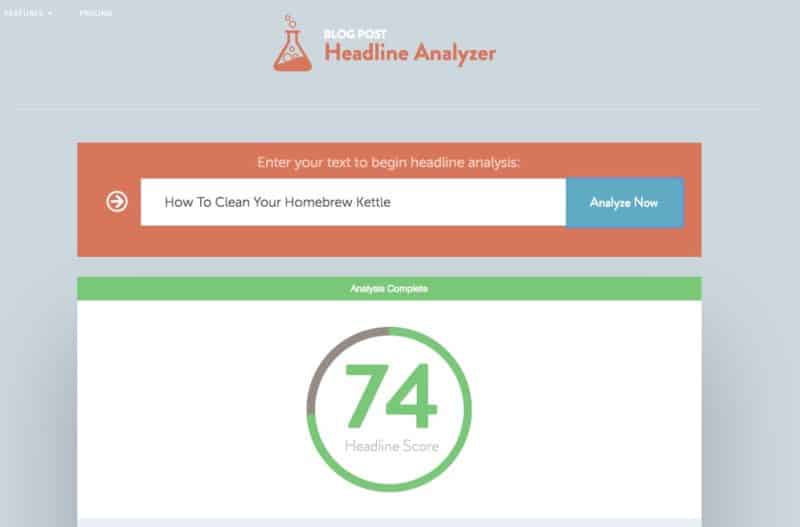 Holy shit! That’s an amazing score!
I literally just did this for the first time, but let’s see if I can make it better by adding some stuff on the end…
Holy shit! That’s an amazing score!
I literally just did this for the first time, but let’s see if I can make it better by adding some stuff on the end…
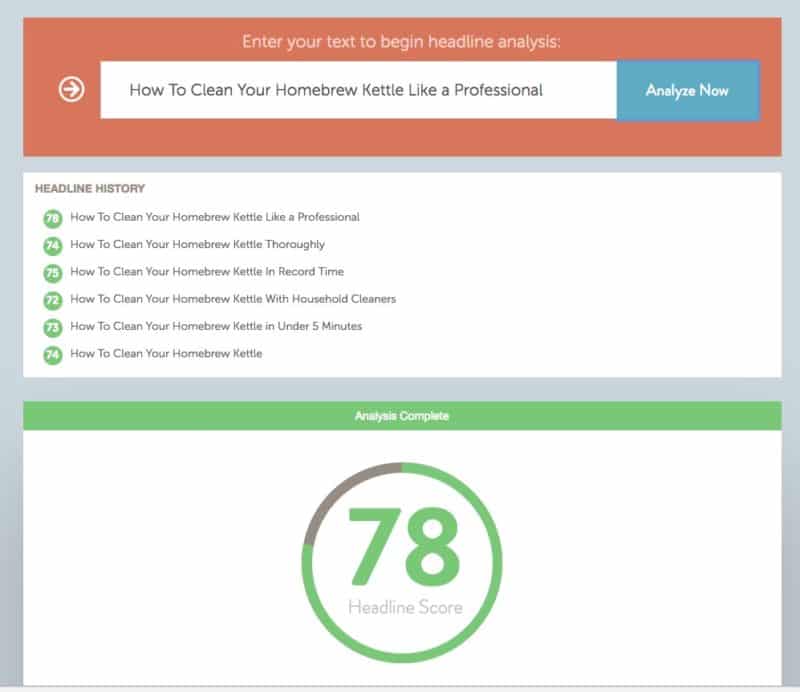 Holy FUCKING shit! I think that might be the best score I’ve EVER gotten using this tool 🙂
I love how it keeps track of all the headlines you’ve tried so you can best yourself, but it looks like this is the headline I would use (adding to Asana now).
The one thing I don’t know is how many people are searching for this phrase. And I don’t care.
I PERSONALLY want to learn how to clean a homebrew kettle! And if I want to learn, then I’m sure others will want to learn, too. I’m NOT going after “low-hanging fruit,” I’m just creating what I would like to exist on the internet. Plain and simple.
The more I create, the more popular the site will become. I’m bound to get a few right and create content that no one else has thought of yet. And that’ll make my site stand out and grow for the long term.
Holy FUCKING shit! I think that might be the best score I’ve EVER gotten using this tool 🙂
I love how it keeps track of all the headlines you’ve tried so you can best yourself, but it looks like this is the headline I would use (adding to Asana now).
The one thing I don’t know is how many people are searching for this phrase. And I don’t care.
I PERSONALLY want to learn how to clean a homebrew kettle! And if I want to learn, then I’m sure others will want to learn, too. I’m NOT going after “low-hanging fruit,” I’m just creating what I would like to exist on the internet. Plain and simple.
The more I create, the more popular the site will become. I’m bound to get a few right and create content that no one else has thought of yet. And that’ll make my site stand out and grow for the long term.
6. Write a Few Articles to Nail Down a System
I like to personally take a shot at a few articles before hiring a writer. This allows me to come up with a system for publishing.- How long should a post be?
- What do the graphics look like and how do they interact with the post?
- Paragraph length, formatting, etc.
7. Hire a Writer and a Graphic Designer To Help
I have a small team who can help: a writer, graphic designer, email marketer, and social media manager. They know how Roasty and SwimU work. However, I would like to try something a little different with this site. I want to hire a writer who homebrews. I’ll first reach out to the Money Lab readers, then the FinCon community (full of freelance writers who maybe homebrew), then a few more people I know who freelance. NOTE: If you’re reading this, and would like to write about homebrewing for this site, shoot me an email with a sample article. As for graphics, my current designer is the tops! He’s responsible for all the article graphics on SwimU and Roasty, and we get complimented on those all the time. Brew Cabin will be completely illustrated, instead of using photos. It allows us to create timeless graphics that are completely unique. And we can also reuse a lot of the same graphics throughout each post. For example, we only have to illustrate a single homebrew kettle. Once we have that element, we can manipulate it in different positions using Adobe Illustrator. We’ll create unique graphics throughout the post to illustrate steps and ideas. We can illustrate custom hop and malt charts, for example, that can be used on multiple posts and downloaded in exchange for an email. I think the illustrations on this site will be the key to its growth!8. Front-load The “Content” Before Launch
I want 10-25 articles published before launching the site. When I launched Roasty, I had eight articles ready to go. And they were small, like 500 words. But each one had a video, so that made up for it. Brew Cabin will not have videos in the beginning. I would like to dive into video in the future, but not until I’ve established a good homebrewing routine that I’m confident in filming. I may save the videos for digital products instead of publishing them for free on YouTube. Not sure yet. Again, I’ll be writing and working with my graphic designer to create these initial posts. This is where most of my time will be spent.9. Develop an Email Marketing Strategy
Recently I’ve been improving the email marketing for Roasty. There are two steps to email marketing:- Getting emails.
- Sending emails.
What’s Next?
As a reminder, this will be an ongoing experiment. So there’s no deadline for getting things up and running. But, I’d like to get the site launched by early February 2017. In the meantime, I’d love to get your opinions and questions on this experiment in the comments below 🙂Designing The Single Post Page And Navigation
I was able to knock out the design of a single post in about an hour. I used the same custom theme I created for the rebranding of Roasty; I just changed the logo, navigation, and color scheme. It took everything in me not to tweak it to death and change a bunch of stuff. Right now I only have one dummy post with an oddly long title to see how it would look.
I also changed the color scheme of the H2 and H3 tags on the post.
Right now I only have one dummy post with an oddly long title to see how it would look.
I also changed the color scheme of the H2 and H3 tags on the post.
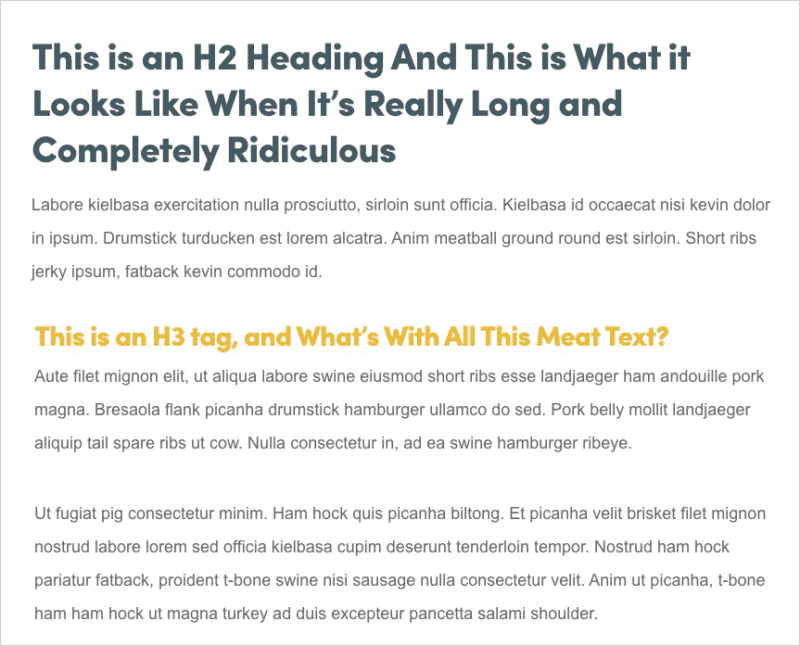 I used Bacon Ipsum to generate the dummy text. Thanks, Jason!
I used Bacon Ipsum to generate the dummy text. Thanks, Jason!
Designing The Homepage
The first thing I did was come up with the headline (or tagline) for the entire site. I did some quick research on other homebrewing sites to see the directions they took. But there were no compelling homebrewing headlines to be found. So I had to start from scratch.The Theme and Direction
I’ve been reading a homebrewing book since I started this project. It’s filled with stuff I’ve learned over the years, but there are parts that get VERY technical. And I thought to myself, “If I was just starting out, this book would have made me give up homebrewing.” There seems to be a theme of mine: taking unnecessary complex topics and making them easy to understand. That was my goal with SwimU and Roasty. The pool and spa industry tends to make water chemistry difficult to grasp. Maybe it’s a sales tactic, but it’s most likely everyone in the industry trying to act smarter than the competition. With coffee, it’s who can be the bigger snob. Who can take coffee to the “next level.” When really, it’s just fucking toasted beans (seeds, actually) soaked in hot water. Come on! Anyway, that’s the same direction I’m taking with Brew Cabin. The bigger audience is people just getting into the hobby, not the ones who nerd out about it. I want to help the beginners first, and slowly incorporate the pros over time. The more people who homebrew, the better!The Headline (or Tagline)
What is my goal Brew Cabin? To teach people how to homebrew. So I started with that. And I used Headline Analyzer to help me improve my first shitty attempt with:Learn The Art of Homebrewing BeerI scored a 56 out of 100. Yikes! I kept improving and changing words to make it more impactful. Eventually, I came up with a winner (with a score of 79)!
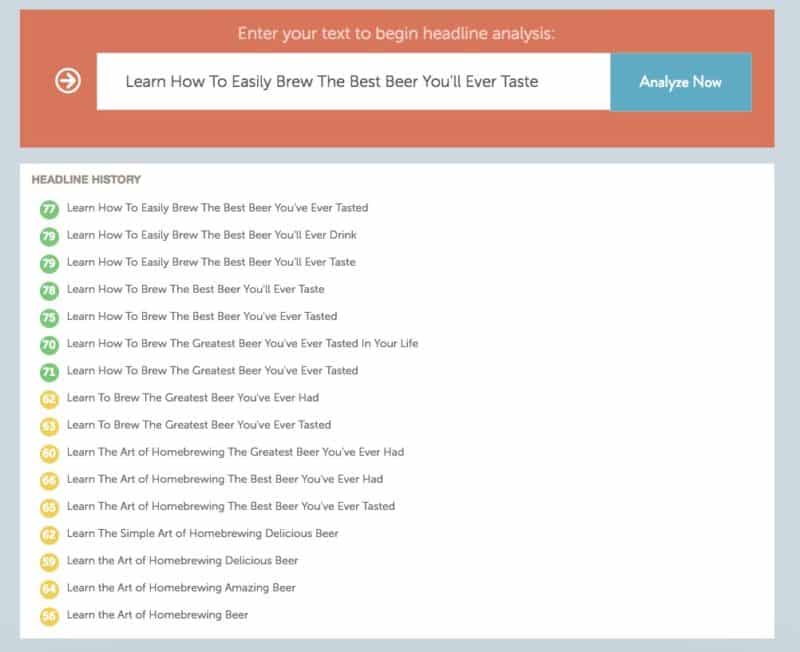 Now I can build a very simple homepage that uses one of my favorite landscapes in the world (and the main reason I moved to Colorado): mountains!
Now I can build a very simple homepage that uses one of my favorite landscapes in the world (and the main reason I moved to Colorado): mountains!
The Homepage Design
Again, I took a lot of the elements I recently recreated for the Roasty rebrand and applied them here. The biggest difference is the logo, font, and background. I found this royalty-free vector image of a mountainscape via Google. I cleaned it up in Adobe Illustrator (I removed some elements mostly). And here’s what it looks like: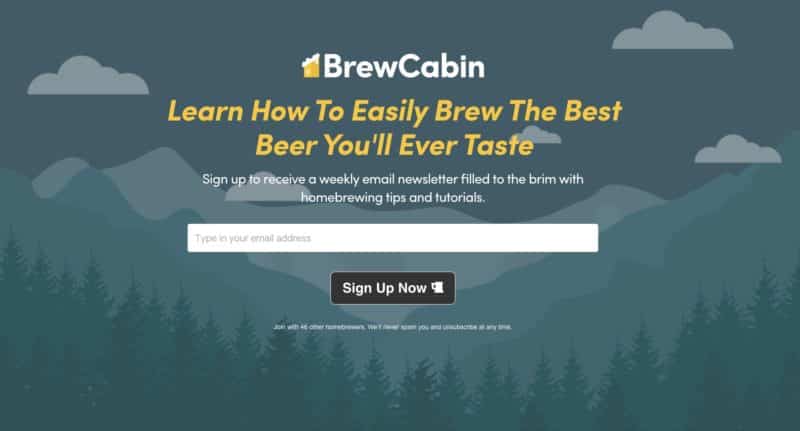 Lower on the homepage will be where all of the latest articles will live. I haven’t actually written any, so there’s nothing to see yet.
Right now, I’m pretty happy with the design. The homepage and the article pages look good. I may have to tweak some elements as I write, but we should be good.
This is live right now, and the signup box works. I custom-coded it myself and hooked it up to MailChimp (which I had to create another list).
What do you think so far?
Lower on the homepage will be where all of the latest articles will live. I haven’t actually written any, so there’s nothing to see yet.
Right now, I’m pretty happy with the design. The homepage and the article pages look good. I may have to tweak some elements as I write, but we should be good.
This is live right now, and the signup box works. I custom-coded it myself and hooked it up to MailChimp (which I had to create another list).
What do you think so far?
Creating a List of Article Topics
I spent only 20 minutes thinking of a bunch of topic ideas. Some were off the top of my head, but most came from the homebrew book I’m reading and other homebrew sites. As we start publishing articles, I’ll reach out to the subscribers to ask for feedback and ideas. This will be ongoing and continue to provide topic ideas. And I’d like to avoid micro-articles that cover an extremely specific topic. For example, an article about a single hop or malt variety. One idea is to create a bunch of articles that outline EVERY hop variety on earth. This is a post that will be constantly updated as new hops arrive on the market. The same goes for yeast and malts.Keeping Track of Articles in Asana
You KNOW I love Asana for running my blogs! So, of course, I’m gonna do it with Brew Cabin, too.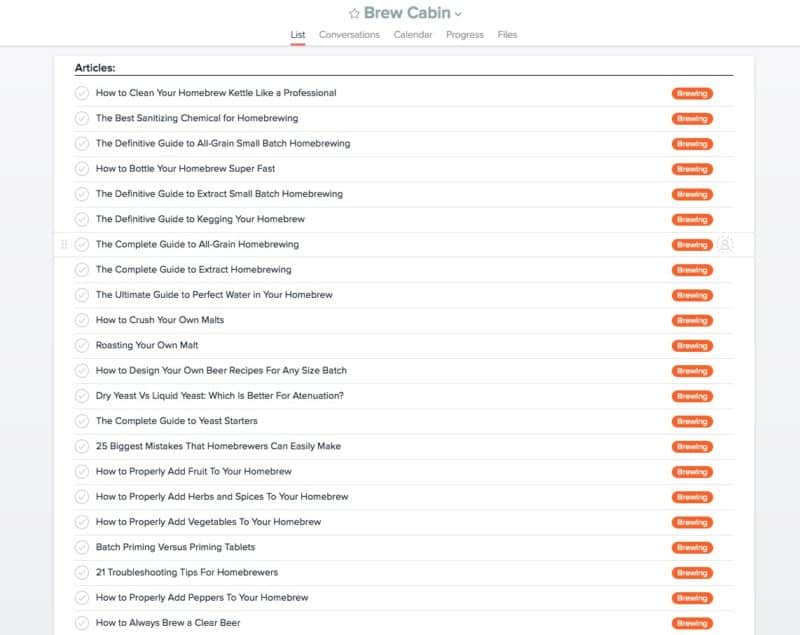 Right now I have 39 topics written down and roughly categorized with tags. I’m actually using the same tags as Roasty: brewing, buying, and facts.
I still have some work to do on crafting the headlines for each of these, but I’m anxious to get started, so I’ll craft some of them on the fly.
Right now I have 39 topics written down and roughly categorized with tags. I’m actually using the same tags as Roasty: brewing, buying, and facts.
I still have some work to do on crafting the headlines for each of these, but I’m anxious to get started, so I’ll craft some of them on the fly.
Hiring Writers
Well, I started getting the word out that I’m looking to hire writers for this project. And the offers came flooding in – I got eight total! So now I have to put people to the test. I’ll give each person a single topic, a recommended word count, and a few other guidelines I haven’t figured out yet. Then, see what comes back. I’ll pay for the articles I get, even if I don’t use them or hire the writer. To start, I’ll offer a $100 per article, and if it’s good, I’ll ask for more and negotiate the price if need be. I’m looking for stellar work, and I hope to be surprised by a few people. Like a box of chocolates, you never know what you’re gonna get. I immediately regret using that analogy.What’s Next?
Before I reach out to the writers, I need to write my own to set the tone. I’ll be working on writing the first, massive article for Brew Cabin. The article will be, “The Complete Guide to All-Grain Small Batch Homebrewing.” I expect it’ll take me a few days to write it and get all the graphics made. So that will be included in the next update along with a hiring status.Quick Homepage Update
A couple of people reached out in the comments and through email with suggestions on improving the homepage copy and design. These suggestions were super helpful, including:- Using the word “Discover” instead of “Learn” in the homepage sub-title. Changing the word didn’t affect the Headline Analyzer score, but I think it looks better.
- Remove the italics from the sub-title.
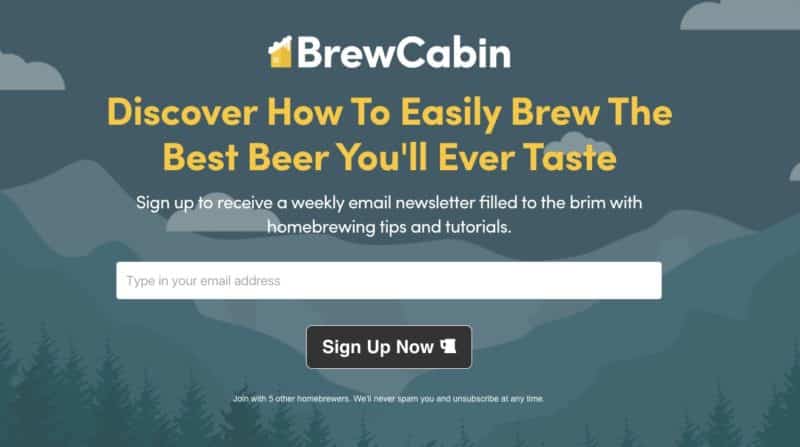 And it looks like there are now 5 subscribers including me on the list 🙂
And it looks like there are now 5 subscribers including me on the list 🙂
Creating The First Article
I spent two days writing the first articles on Brew Cabin. I could have done it in one day, but I hosted a little co-working event at my house and just spent the whole time talking and drinking. The article is currently titled, “The Definitive Guide to Small Batch Homebrewing” and it’s live, but not fully complete. I wrote 2,345 words, but I haven’t done any editing yet.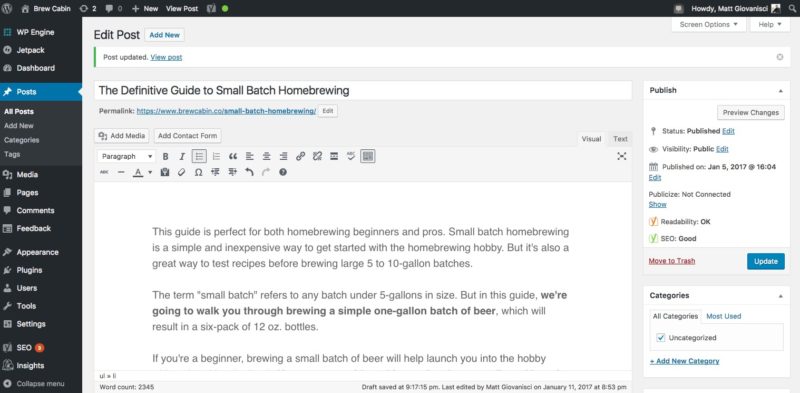 This article is especially long because it’s the entire brewing process. Once I get this article really dialed in, it can be used over and over again. Even parts of it can be used in other articles. This also sets the tone for the articles going forward.
This article is especially long because it’s the entire brewing process. Once I get this article really dialed in, it can be used over and over again. Even parts of it can be used in other articles. This also sets the tone for the articles going forward.
Adding Graphics
As I’m editing and formatting the article, I’ve started sending over graphic tasks to my designer. The plan is to have him custom illustrate individual brewing items, like a kettle, siphon, fermentors, etc. Each graphic will be vector and created in Illustrator, which I’m familiar with. I can then use these graphics to create step-by-step graphics for each section of the article. I like using custom graphics over photos because it makes them timeless and brand-less. I can illustrate a single brew kettle that can be used to represent ALL kettles. I’ve been working with my graphic designer for two years and we have a dialed-in system. We manage everything using Asana, of course. Here’s how I’ll be sending him these graphic tasks: The task name is the name of the product plus the word “graphic” for added clarity. In each task, I included an image of the product I found on Google Image Search. And you gotta have a deadline. I’m giving him a week, but that may change after he completes a few.
The task name is the name of the product plus the word “graphic” for added clarity. In each task, I included an image of the product I found on Google Image Search. And you gotta have a deadline. I’m giving him a week, but that may change after he completes a few.
Working With an Editorial Team
Things have gotten chaotic during this experiment because I started a challenge and another experiment at the same time. To recap:- I built a minimal version of BrewCabin.com to start adding articles.
- I’ve written, formatted, and published the first article as a benchmark for future posts.
- I reached out to three writers and already published their work: here and here.
Creating Video Training Materials
I hired my first writer for SwimUniversity.com two years ago. To explain how I wanted things to be published in WordPress, I created a screen recording and narrated as I published a post on SwimU in real-time. I sent this video to the writer, and after he watched it, he knew exactly how I wanted posts to be published on SwimU. I’ve continued to make tutorial videos like this. I use Screenflow to record it and I store all the videos in a public project in Asana called “Tutorials & Resources.”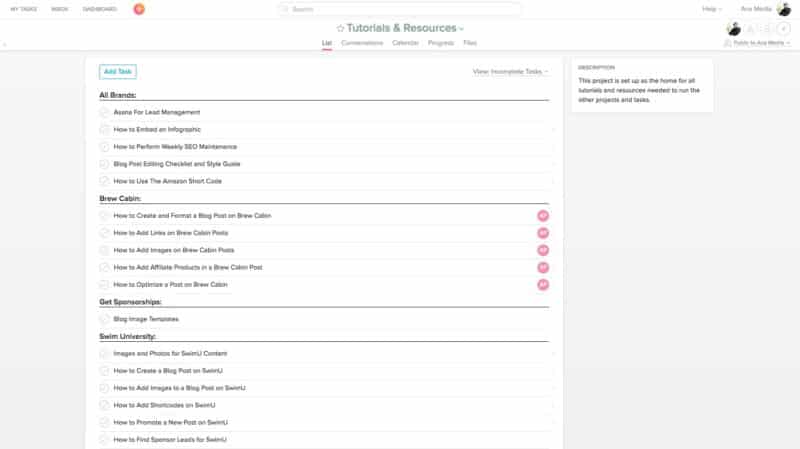 For Brew Cabin, I filmed six videos, all documenting the entire editorial process. These videos include:
For Brew Cabin, I filmed six videos, all documenting the entire editorial process. These videos include:
- How to create a format a post in WordPress for Brew Cabin.
- How to add links (both normally and with my custom shortcode for internal linking).
- How to add featured images, main images, and a long Pinterest image at the bottom of the post.
- How to add affiliate products from Amazon using the Simple URL plugin and my custom Amazon plugin with a shortcode.
- How to optimize a post using the Yoast plugin.
Team Setup
I’m currently setting up one of the writers. I’ve given her access to my Slack team and created a channel for chatting about #BrewCabin. I’ve also added her to my Asana team, which bumped me up to a higher pricing plan. Now I’m paying for 10 members at roughly $500 a year.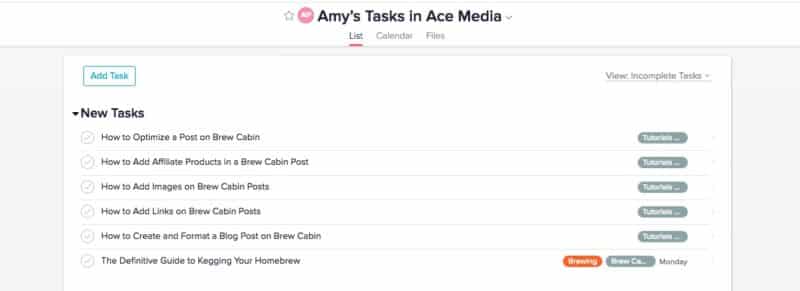 I’ve assigned her all the videos to watch and her first scheduled post. I created her an account in the Brew Cabin WordPress admin as a “contributor” to start.
Contributors can write but can’t publish without approval. For the first few articles, I would like to review them before they get published to make sure the formatting is on point.
Once things are running smoothly without my intervention, she’ll be on her own to write and publish posts at least once a week.
If your at all interested in how to run my editorial calendars for SwimU, Roasty, and Brew Cabin, you should buy Asana for Bloggers.
I’ve assigned her all the videos to watch and her first scheduled post. I created her an account in the Brew Cabin WordPress admin as a “contributor” to start.
Contributors can write but can’t publish without approval. For the first few articles, I would like to review them before they get published to make sure the formatting is on point.
Once things are running smoothly without my intervention, she’ll be on her own to write and publish posts at least once a week.
If your at all interested in how to run my editorial calendars for SwimU, Roasty, and Brew Cabin, you should buy Asana for Bloggers.
My Obvious Pick
Asana For Bloggers: Manage Your Editorial Calendar With Asana [COURSE]
Get Instant Access Today!
Get organized and better at managing your blog. In this video course, I'll walk you through how I use Asana to manage my own blogs.
Matt Giovanisci (me) earns a commission if you click this link and make a purchase at no additional cost to you.
![Asana For Bloggers: Manage Your Editorial Calendar With Asana [COURSE]](https://www.moneylab.co/wp-content/uploads/Asana-For-Bloggers-Podia.png)

